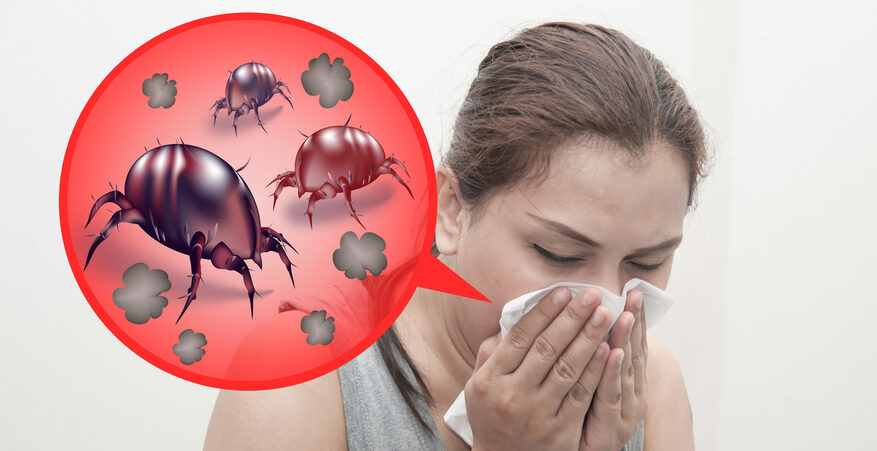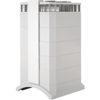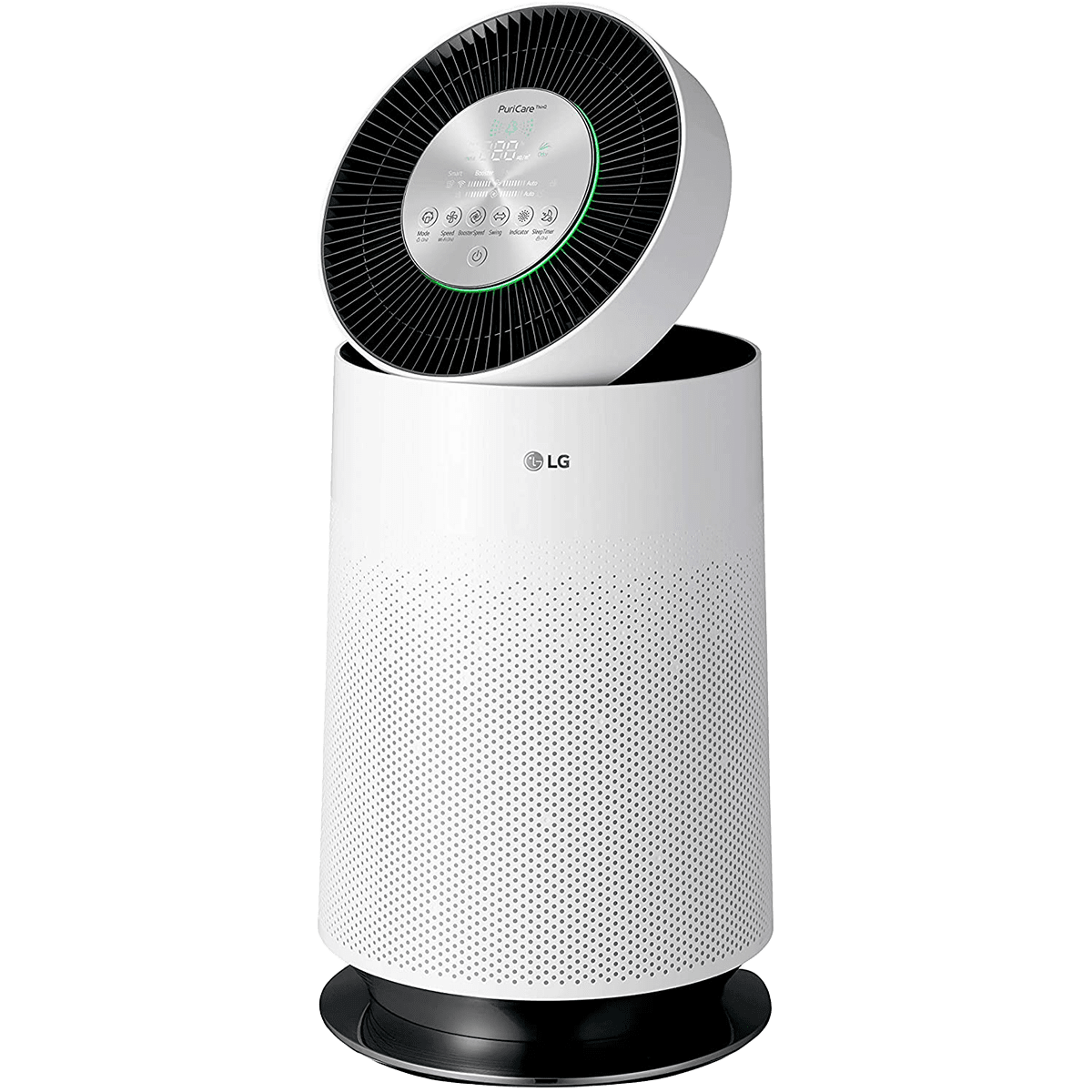Dust Mites

Dust Mite Allergies, Bites, Symptoms and Treatments
By The Air Purifier
According to the AAFA (Asthma and Allergy Foundation of America), around 20 million Americans are allergic to dust mites, meaning they're one of the most common triggers of allergies and asthma. Dust mites are tiny creatures, invisible to the naked eye.
While most people experience only mild symptoms from dust-mite allergies (itching nose and eyes, sneezing), for some people with severe asthma or other respiratory problems, it could mean life or death.
These pesky critters, invisible to the naked eye, live in your pillows, mattresses, and carpets, and feed on dead skin cells shed by humans and pets. They thrive in warm environments and can't survive at temperatures below freezing. Dust mites live in damp areas, such as humid cities or households with poor ventilation.
Dust-mite allergy symptoms can be triggered by as few as 10 to 15 of them in an area the size of 2 square inches. In fact, they are the primary allergen found in house dust and are one of the most common triggers of allergic rhinitis and asthma.
Dust Mite Size
 They are 1/100 of an inch long or 1/4 to 1/3 millimeters long which make them to small to see with your naked eye. Unfortunately, you can only see them under a microscope and they look like spider-like creatures.
They are 1/100 of an inch long or 1/4 to 1/3 millimeters long which make them to small to see with your naked eye. Unfortunately, you can only see them under a microscope and they look like spider-like creatures.
Dust Mite Symptoms
Dust Mites can eat 10 grams of dead skin cells each person or pet who inhabits the bed sheds each week. The result is that humans are breathing in dust mites and dust mite excretions every single day.
Even as the body attempts to protect itself from the dust mites feces by producing antibodies that create histamines, the addition of the histamines causes the swelling of the respiratory passages, and nasal congestion.
The Microscopic Dust Mite can cause any or all of the following symptoms:
- watery eyes
- runny nose
- sneezing
- itchy, red, watery eyes
- nasal congestion
- itchy nose and throat
- nasal drip
- cough
- facial pain
- swollen skin
Reactions to Dust Mite Feces
Depending on the person's physiology, he or she may suffer from allergic reactions such as Asthma, Hay fever, and Eczema because of the mite feces and enzymes in household dust. Dust mites can be deadly to people with severe allergies.
Those with sensitivities can be plagued with something as simple as a runny nose or as complicated as chronic reactions that can dramatically affect a person's health and well-being. Unfortunately, the most serious exposure to dust mite allergens is experienced when sleeping or when the dust has been disturbed.
Have you ever had the sniffles in the morning when you first wake up? Have you suffered from sinus-type headaches, itchy eyes, and sneezing? If so, it may be because of those pesky dust mites who are hiding in your bed.
Dust Mite Bites (1)
Creates intense itching and many small, red bumps like pimples, are seen. Burrows may also be seen, these look like thin, wavy lines.
Dust Mite Treatments (2)
- Clean Area with soap and water.
- Using antihistamine if needed for itching. (Pill, liquid, cream or ointment)
- Apply cool compresses or ice pack to area.
- Use other creams for swelling or pain.
- Take Acetaminophen, as directed for pain.
How to get rid of Dust Mites
Quality Air filtration, controlling Humidity Levels and dust mite Elimination will all help with dealing with dust mite related problems.
- Use a Hepa Air Purifier to filter out all those dust mites which can get into the air and cause serious health issues if inhaled.
- Use a Dehumidifier to lower your humidity level in your home to below 50% because mites will breed & multiply at levels above 50%. Normal humidity levels are between 30% to 50%.
- Try cleaning your Mattresses & Carpets with a Vapor Steam Cleaner because it can kill mites with hot dry steam & no chemicals.
Air Purifiers to remove Dust Mites
Because they're so small -- less than 1/3 millimeter long -- these pests are difficult to remove with conventional cleaning alone. Luckily, there are many effective ways to get rid of them: vacuuming, washing bedding and curtains on hot settings (130°F), installing an allergen-proof mattress cover and pillowcases, etc.
An Air Purifier is a good option if you're looking for a way to eliminate dust mites and other allergens from your home.
Air purifiers can reduce the number of airborne contaminants in your home, including dust mites, using high-efficiency filters and other technologies to clean the air as it passes through the equipment. But be aware that you have to place an air purifier in a place that maximizes its efficiency.
A randomized-controlled study of 30 adults with asthma found that HEPA (high-efficiency particulate arresting) air filters improved symptoms of adults with asthma who lived with a cat or dog (a source of dust mites). HEPA air purifiers are the best choices since studies show they're superior to air cleaners that use ionization.
Plus, ionization air purifiers produce ozone as a byproduct. Ozone can harm your health if you breathe it in high amounts over a long period of time or shorter periods at high levels. Breathing ozone may make asthma worse and trigger asthma attacks more often.
Air Purifiers Must Have Good Air Flow
To get the most out of an air purifier, it must have enough space to work effectively. If there's no airflow, the purifier is just spewing dirty air back out into the room.
As a rule of thumb, leave at least one foot on each side and behind the purifier free of furniture or walls so that it can easily pull in and push out clean air. Don't put an air purifier in a room with stagnant air and expect it to do its job.
Uncluttered Rooms
Have you ever put on clothes that have been sitting untouched in your closet for months? If you have, you may have noticed a lot of dust flying around. That's because air needs space to move around -- and it can't do that if the area is cluttered.
Other airborne particles like pollen and cigarette smoke work the same way. That's why air purifiers need a decent amount of space to do their job.
A good rule of thumb is to keep furniture and storage boxes away from walls and at least two feet from vents or any other openings into a room. A perched television could also block an air purifier's vents, which would cause it to recirculate dirty air back into the room instead of cleaning it.
The requirements for optimum capacity vary greatly depending on the size of your unit. A small bedroom will require a smaller unit than a large living room, as a larger space means more airborne pollutants. On the other hand, using a large unit in a small space can be detrimental to its performance by crowding out any must-needed breathing room.
Some air cleaners are designed to purify the air throughout the house. These high-capacity units generally work in tandem with your forced-air heating and cooling system.
Conclusion
If you suffer from allergies and want to know if air purifiers can help with dust mites, the answer is that they can help. Air purifiers are designed to remove pollutants from the air of indoor environments.
They do this through a variety of mechanisms, including activated carbon filters, ozone generators, electrostatic precipitators, and/or HEPA filters. Dust mites are among the many types of allergens that these devices can remove from the air.
References
- Dust Mite Bites - Flea, Mite or Chigger Bites - https://www.cedars-sinai.org/health-library/diseases-and-conditions/f/flea-mite-or-chigger-bites.html - cedars-senai.org
- Dust Mite Treatment - Flea, Mite or Chigger Bites - https://www.cedars-sinai.org/health-library/diseases-and-conditions/f/flea-mite-or-chigger-bites.html - cedars-senai.org
Resources
- Sublett JL. Effectiveness of air filters and air cleaners in allergic respiratory diseases: a review of the recent literature. Curr Allergy Asthma Rep. 2011;11(5):395-402. doi:10.1007/s11882-011-0208-5.
- "What are ionizers and other ozone generating air cleaners? - US EPA." 03 Mar. 2021, .epa.gov/indoor-air-quality-iaq/what-are-ionizers-and-other-ozone-generating-air-cleaners.
- What's the Difference: Air Purifier vs Dehumidifier? - AllergyConsumerReview, https://www.allergyconsumerreview.com/air-purifier-vs-dehumidifier.html.
About the Author
She is a Medical Doctor with a concentration in Family Practice. She also has an undergraduate degree in both Biology and Psychology and masters in Clinical Pathology.
Testing
Best Allergy Purifier
Remove Dangerous Allergens like:
- Dust Mites, Bacteria
- Mold Spores & Pet Dander
- Pollen, Smoke & Viruses
- VOC's & more...
Certified (AAFA) & Energy Star (EPA)
Allergy & Asthma Friendly
Order Now >>
 Disclaimer: Articles not intended to Diagnose, Treat, Cure or Prevent Diseases.
Disclaimer: Articles not intended to Diagnose, Treat, Cure or Prevent Diseases.
Issues | Conditions | Products | Testing




